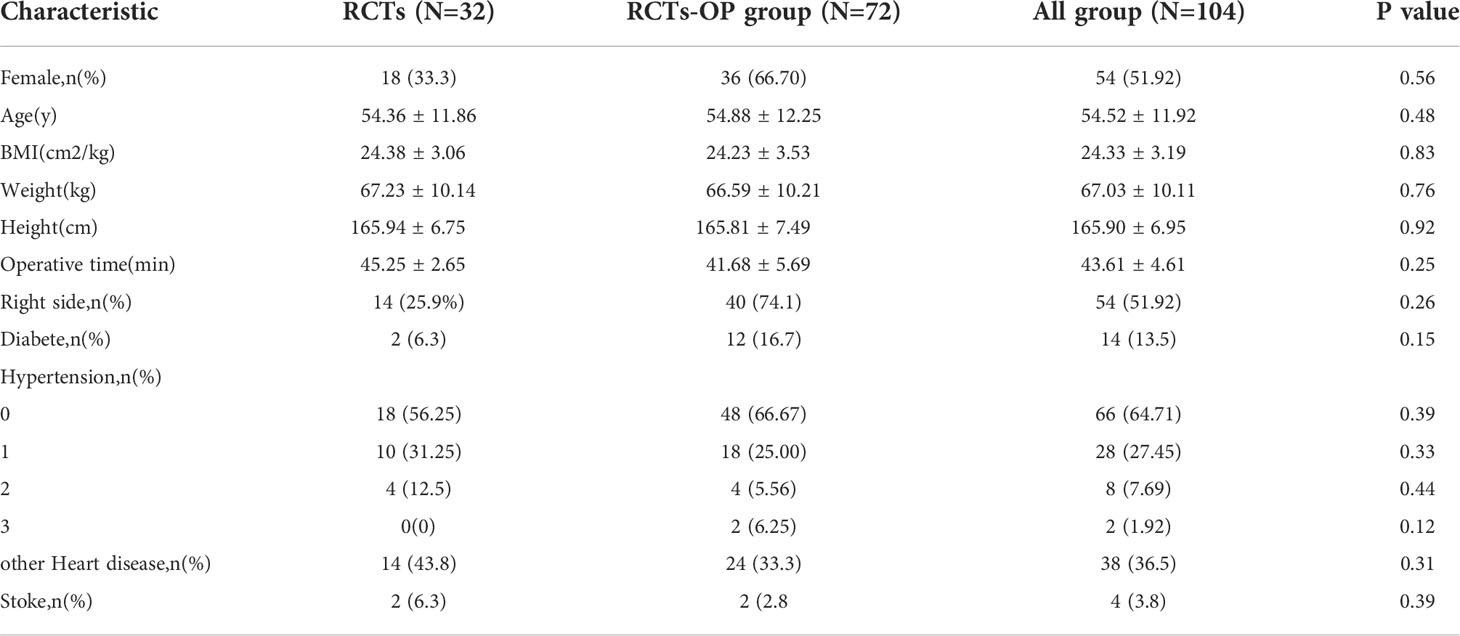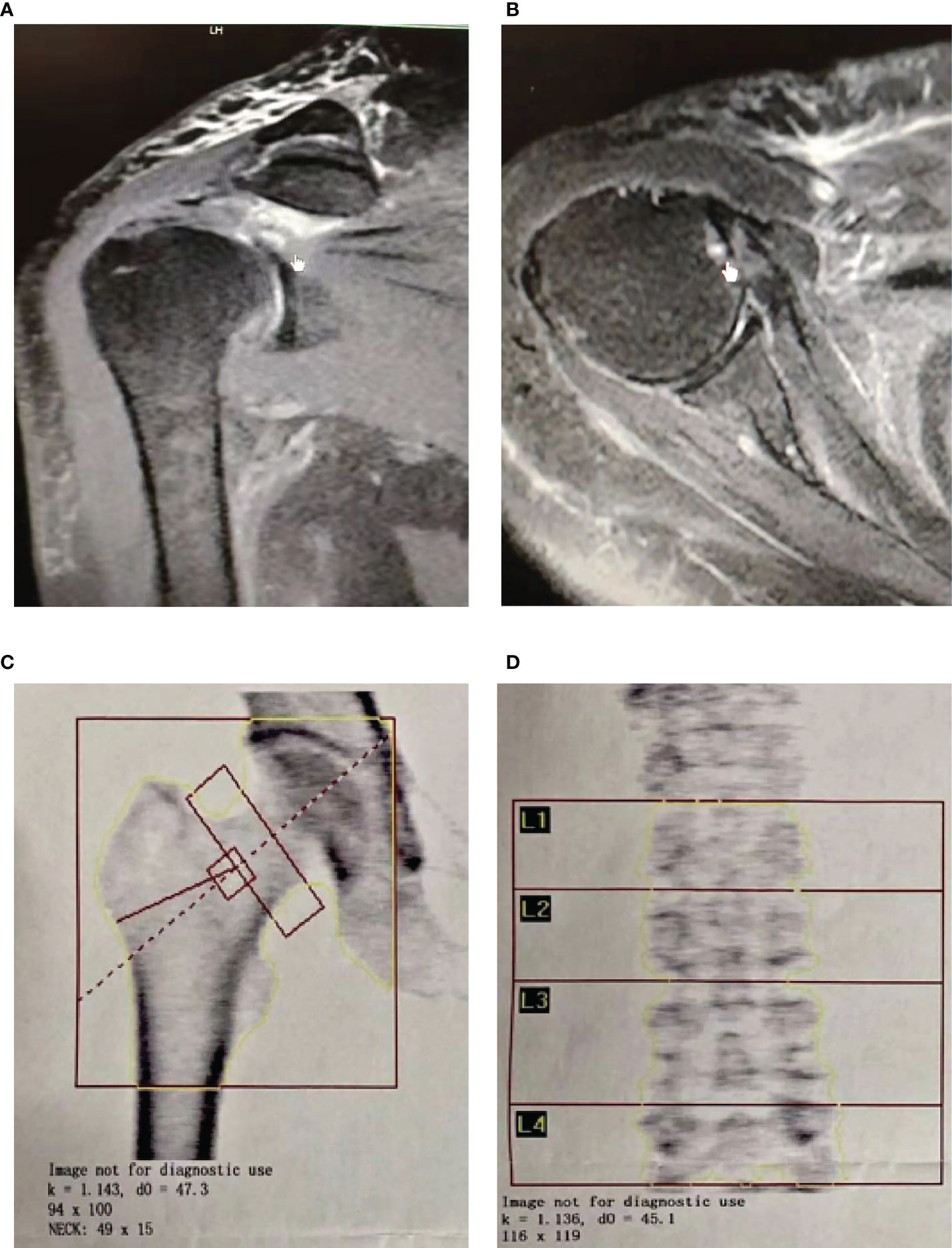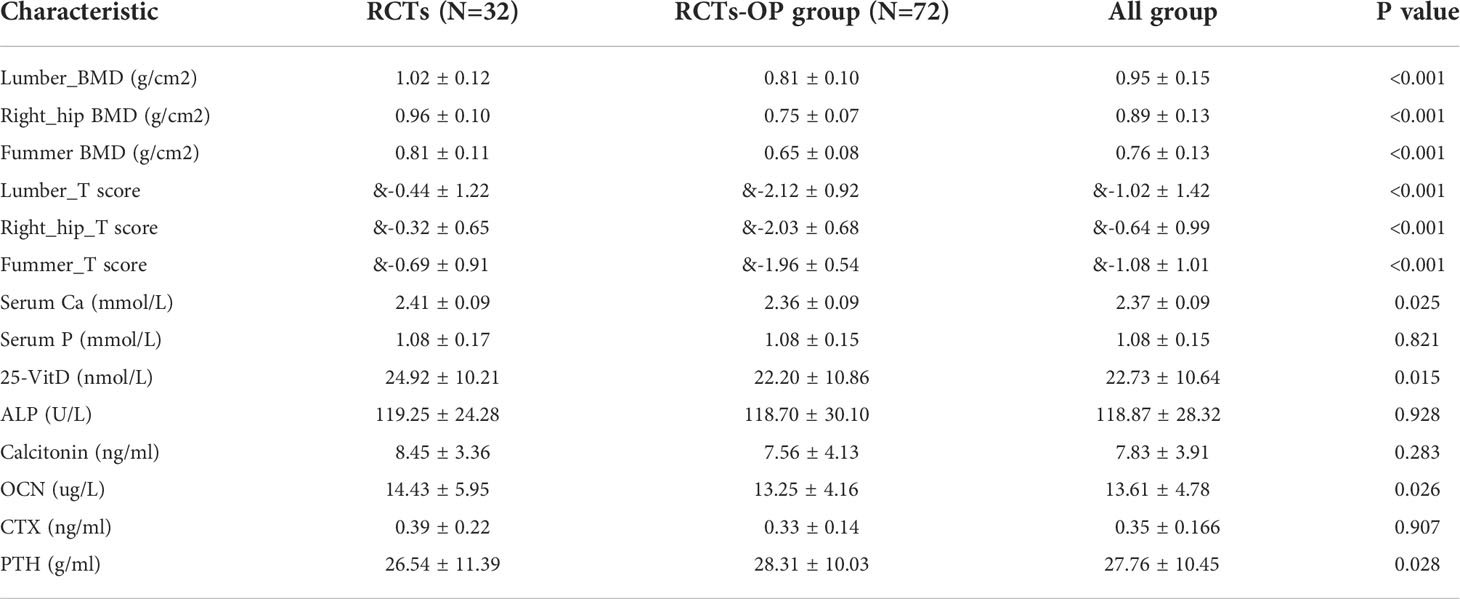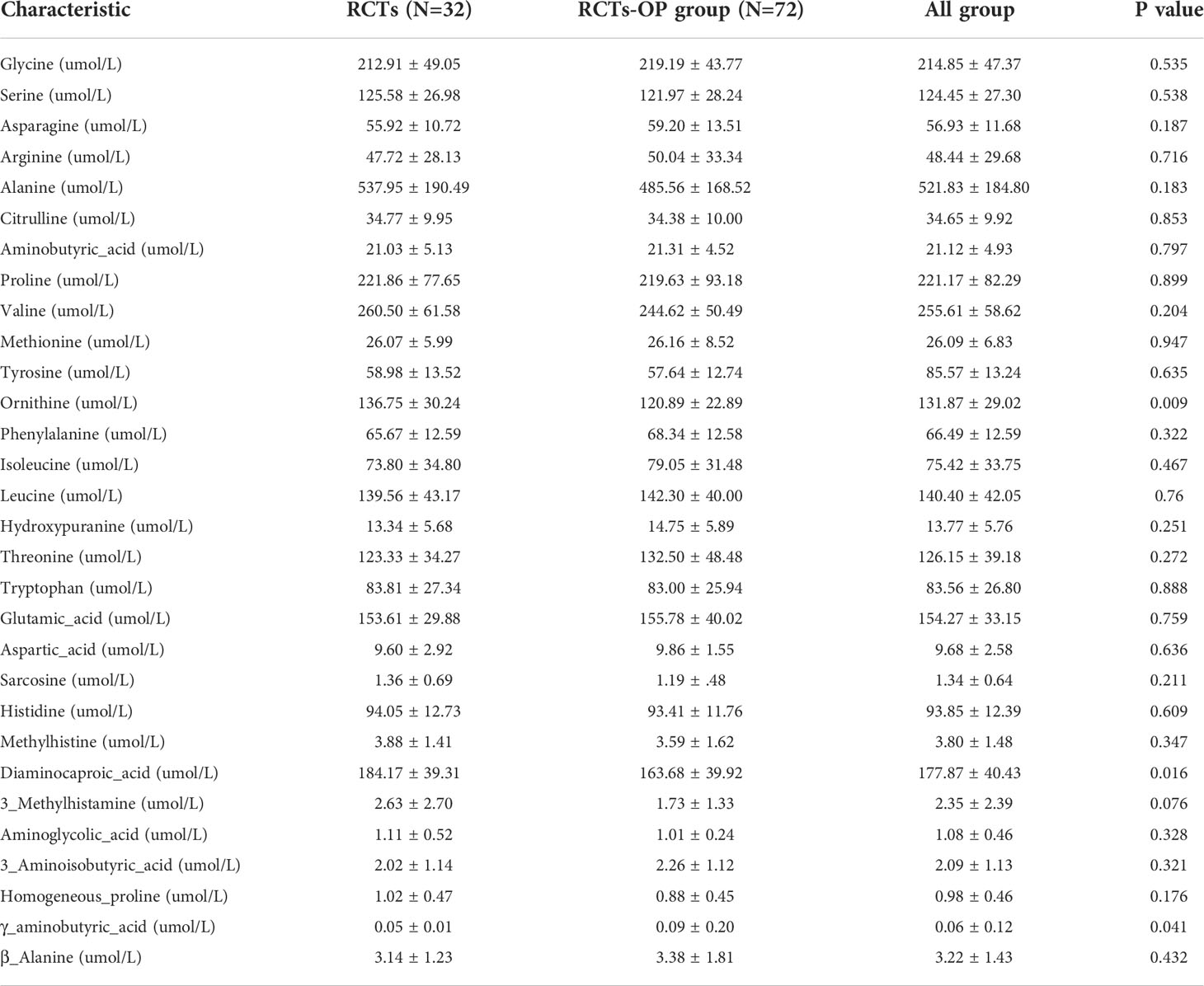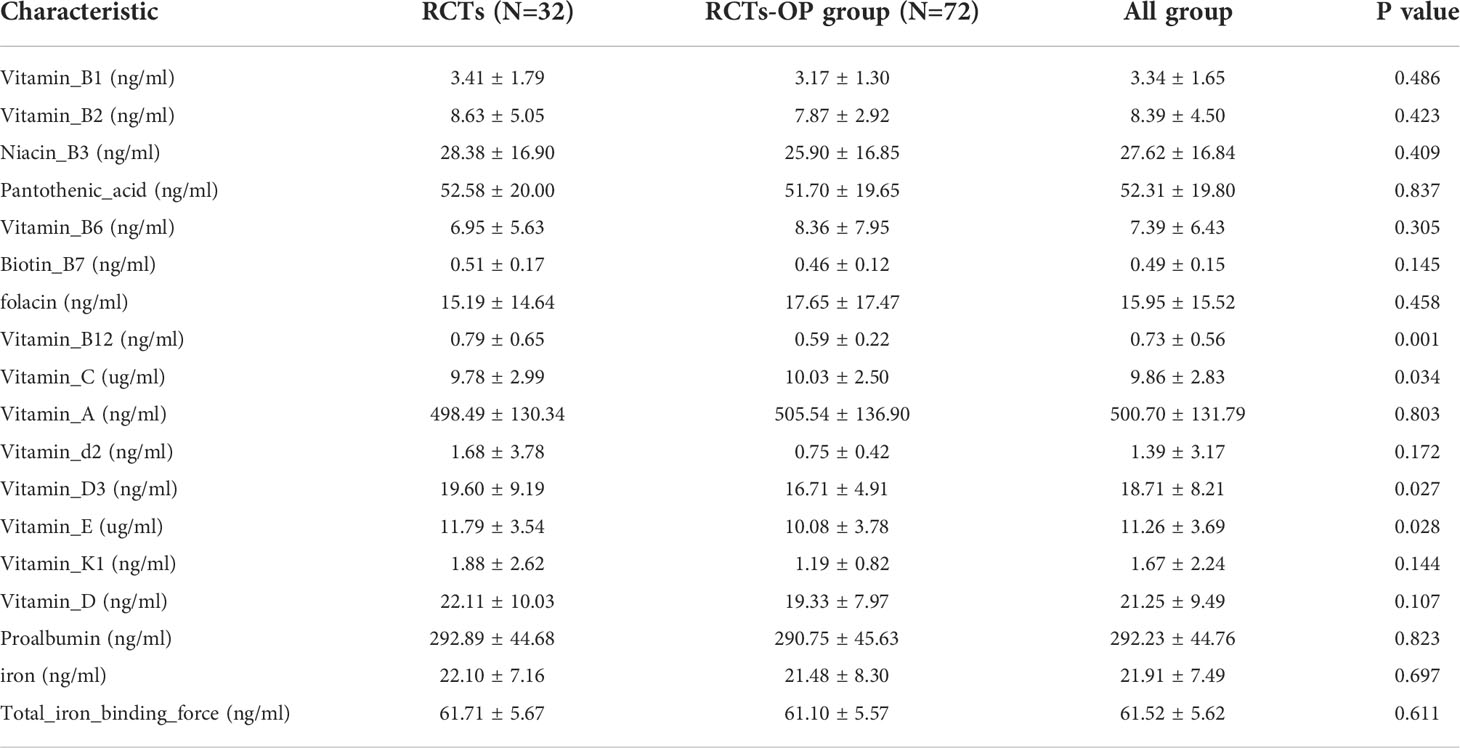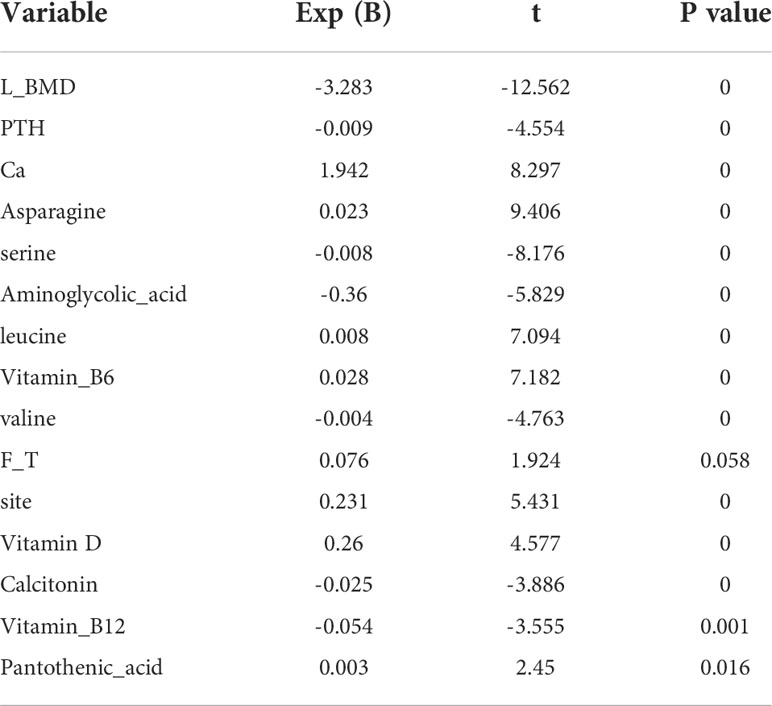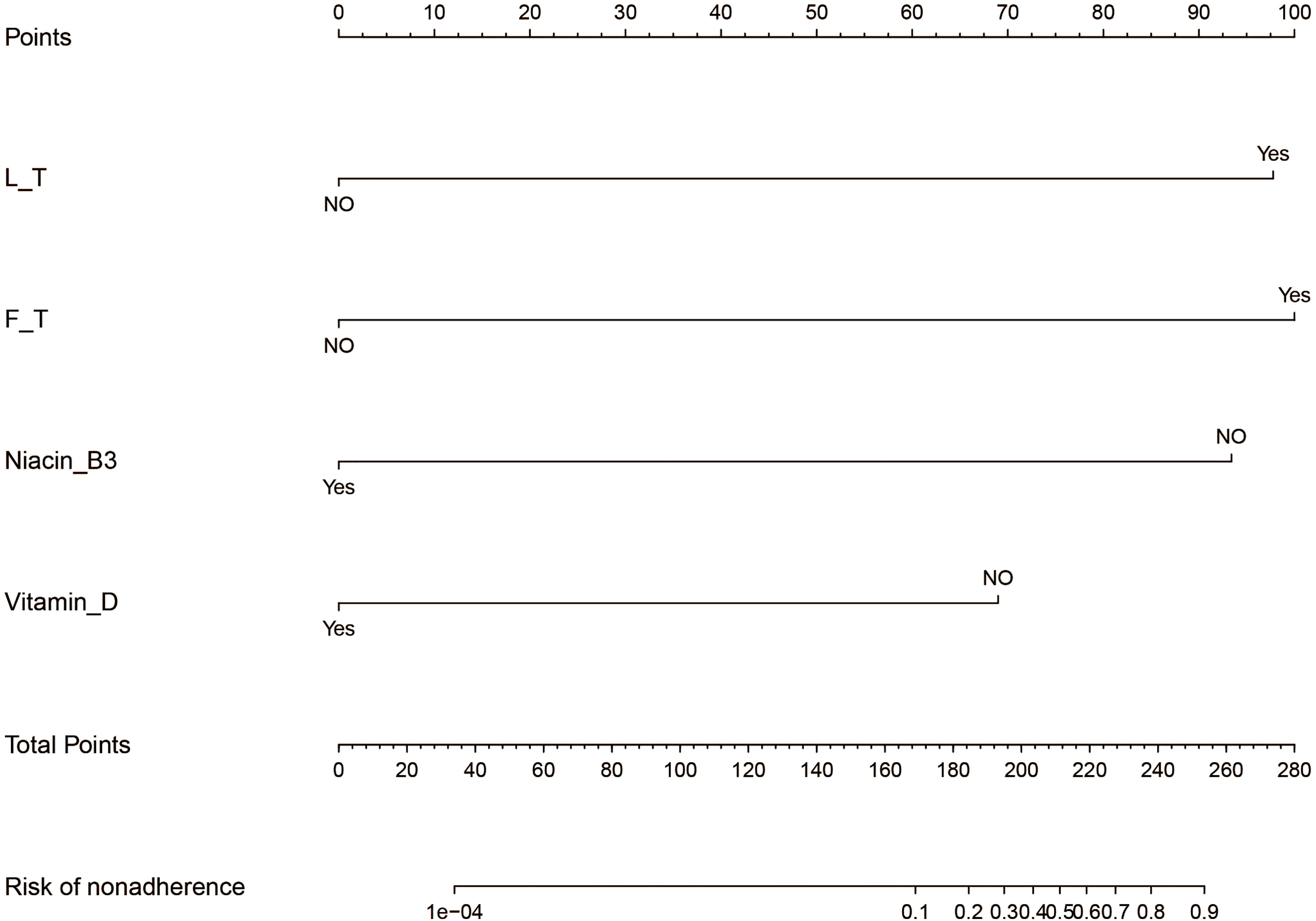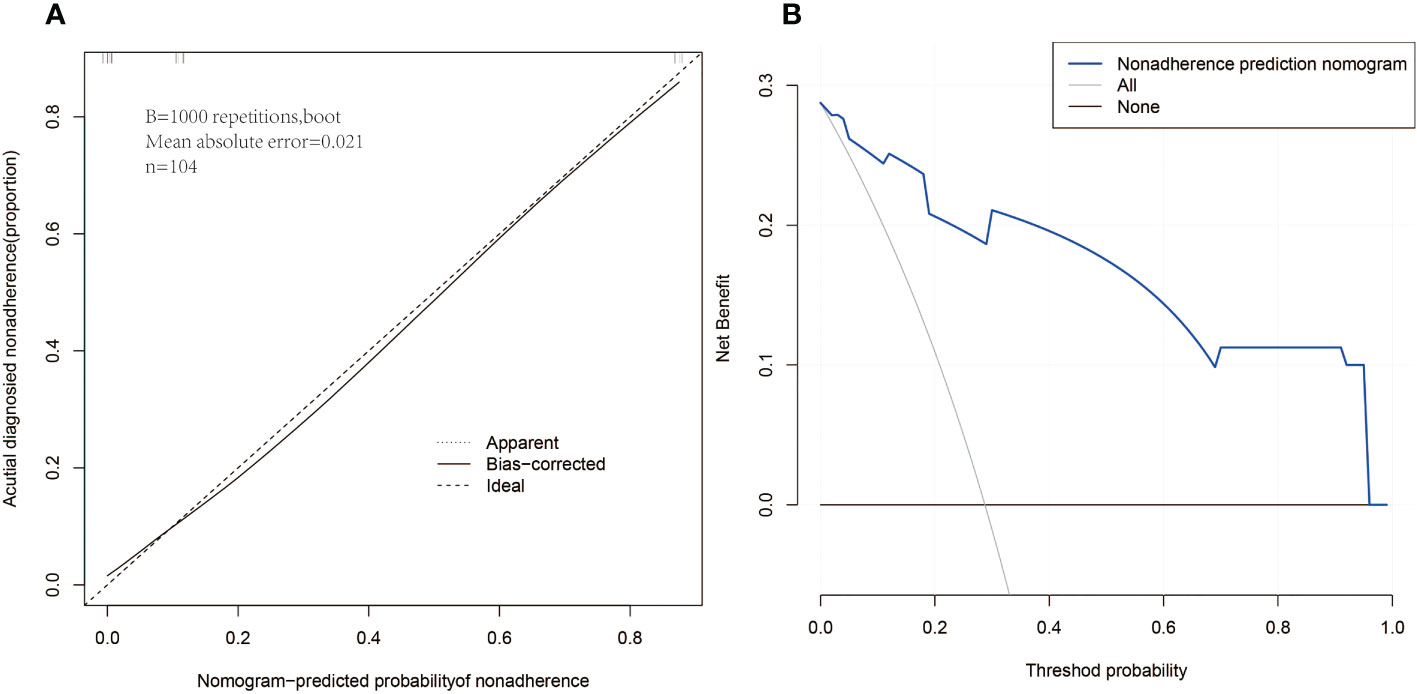- 1Department of Orthopedics, The Shanghai Tenth People's Hospital of Tongji University, Shanghai, China
- 2Department of Medical Iconography, Shanghai Changzheng Hospital, Naval Medical University, Shanghai, China
- 3Department of Orthopaedics, Yinshanhu Hospital of Wuzhong District, Suzhou, China
Backgrounds: Osteoporosis (OP) is an important risk factor for rotator cuff tears (RCTs). However, the relationship and mechanism between rotator cuff injury and osteoporosis are unclear. Therefore, to investigate association between rotator cuff injury and osteoporosis, and find clinical characteristics, bone mineral density, bone metabolism markers, and nutrient levels in rotator cuff injury patients with or without osteoporosis.
Methods: One hundred and four cases of patients (RCTs, n=32; RCTs-OP, n=72) who underwent rotator cuff injury and need arthroscopic rotator cuff repair between June 2021 and February 2022, along with the diagnosis of osteoporosis were identified from the dual-energy X-ray bone density screening(DXA). The outcome measure includes clinical characteristics, bone mineral density, bone metabolism markers, vitamins, and amino acids. Multivariable logistic regression analysis was applied to build a predicting model incorporating the feature selected in the least absolute shrinkage and selection operator regression model. Discrimination, calibration, and clinical usefulness of the predicting model were assessed using the C-index, calibration plot, and decision curve analysis. Internal validation was assessed using bootstrapping validation.
Results: OP with RCTs has a lower level of in 25-vitD, osteocalcin (OCN), serum Ca2+, ornithine, diaminocaproic_acid but the high level of Vitamin_B12, PTH, Vitamin_D3,γ_aminobutyric_acid, Vitamin_C and Vitamin_E than RCTs patients without OP. Predictors contained in the prediction nomogram included lumber T score, femur T score, Niacin_B3, and vitamin D, reflecting the combined effect of vitamins on RCTs-related OP progression. The model has good discriminative ability with a C-index of 0.938(95% CI:-1.83-1.39) and good scaling ability. The high C-index value of 0.95 is still achievable with range validation. Analysis of decision curves showed that non-adherence is clinically useful when intervention decisions are at the 14% probability limit of non-adherence.
Conclusion: This study supports the hypothesis that lumber T score, femur T score, Niacin_B3, and Vitamin D are valuable prognostic biomarkers on RCTs related OP progression.
What is known about the subject: It is found that vitamin D are valuable prognostic biomarkers, reflecting the combined effect of vitamins on RCTs related OP progression.
What this study adds to existing knowledge: These findings also highlight that nutrients condition such as vitamins and amino acids of patients provide a new understanding of the development of RCTs.
Introduction
Rotator cuff tears (RCTs) is one of the diseases that severely affect the movement of the shoulder joint in patients, with an incidence of about 15-20% in patients aged 60 years, about 26-30% in patients aged 70 years, and 36-50% in patients aged 80 years (1). With the accumulation of factors such as increasing exercise patterns or aging, the incidence of RCTs is increasing significantly, which bringing serious pain and loss of function (2, 3). RCTs also carry a huge financial burden, bringing about $3-5 million a year in the United States (4). The probability of re-tearing after a rotator cuff tear is about 20-40%, which also suggests that there is a risk of poor healing of tendons embedded in the bone (5–8). However, there are still significant deficiencies in poor rotator cuff repair capabilities and current limitations of surgery and injection therapy (9). Therefore, it is of great significance for further study of the mechanism of rotator cuff injury.
Vitamins and amino acids have been reported to improve tendon and muscle mass by inhibiting collagen metabolism and reducing tendon flexibility (10–12). In a mouse model, vitamin D (VitD) prevented local decrease in bone mineral density (increased roughness of the proximal humerus) and improved rotator cuff tendon healing (12). Low serum vitamin B12 levels are associated with degenerative rotator cuff tear (13). In addition, leucine ameliorated tenotomy-induced muscle atrophy by inhibiting autophagy and possibly activating the PI3K/AKT/mTOR pathway in rotator cuff injury (14). However, there are no established biologic factors of vitamin and amino acids to improve tendon to bone healing. Therefore, it is important to find specific treatment strategies or drugs that can improve patient outcomes in large-scale randomized controlled trials.
Osteoporosis is a serious health problem that seriously affected the health of the elderly population, affecting 200 million people worldwide (15–17). In joint-related diseases, osteoporosis was a dependent risk of in patients who required total knee repalcement (18). The diagnosis of osteoporosis is mainly based on dual-energy X-ray absorptiometry (DXA) analysis, and a T value of bone density less than -2.5 is diagnosed as osteoporosis (19, 20). Differences in recovery rates have led many studies to investigate factors that may contribute to structural failure with rotator cuff, such as age, smoking, tear size, fatty infiltration, and metabolic syndrome (21, 22). In addition, osteoporosis is a other risk factor in the prognosis of rotator cuff injury and is thought to significantly increase the risk of re-tearing after rotator cuff repair (10, 23–25). However, there is a lack of in-depth research on the close relationship between osteoporosis and rotator cuff injury. For example, whether the bone quality will affect the loosening of the anchor or cause the anchor to fall out at the beginning of fixation, which will lead to the failure of rotator cuff repair surgery (26, 27).
Considering that the relationship between full-thickness tears of the rotator cuff and osteoporosis also increases significantly with age, this further indicates that osteoporosis has obvious significance for rotator cuff injuries (28). In this paper, the central thesis is 1)to analyze whether there is a correlation between bone mineral density (BMD) in the lumbar spine, humerus, and femoral head of patients with rotator cuff injury and its relationship with clinical features. In addition, 2) we also developed an efficient and simple predictive tool to assess the risk factors of vitamins, amino acid levels, and markers of bone metabolism in patients with rotator cuff injuries combined with osteoporosis.
Materials and methods
This study is a single-center, prospective cross-sectional study. This study was approved and approved by the ethics committee and the institutional review board (IRB) of our Hospital. All patients were informed and signed an informed consent form. According to the CONSORT guidelines, these studies also comply with the Declaration of Helsinki.
Patients
The study recruited 104 patients from our hospital who required rotator cuff surgery at the author’s institution in June 2021 and February 2022. We included patients with full-thickness rotator cuff tears treated only arthroscopically and confirmed by arthroscopy, and patients with postoperative rotator cuff integrity confirmed by magnetic resonance imaging (MRI).
The study included patients who were at least 50 years old and who passed one of the above RCT tests. Exclusion criteria were: (1) previous shoulder surgery; (2) previous known shoulder lesions; (3) wheelchair or bedridden persons; (4) active tumor pathology, neurological syndrome, peripheral neuropathy, Obesity, moderate to severe cognitive impairment, and other chronic diseases; history of fragility hip fracture. In addition, rotator cuff injuries due to trauma or sudden strenuous exercise are excluded. Patient demographics and other characteristics were recorded, including age, gender, location, time of surgery, smoking status, hypertension, and other cardiac conditions (Representative Rotator Cuff Injury Video 1-3).
Study outcomes
Osteoporosis is diagnosed primarily based on total hip or hip BMD T-score ≤-2.5 and 1 or more moderate or severe vertebral fractures or 2 or more mild vertebral fractures; o Total femoral neck or femur BMD T-score of -2.0 or lower, and 2 or more moderate-to-severe vertebral or proximal femur fractures (29). The lumbar spine and proximal femur were then assessed for BMD by dual-energy X-ray absorptiometry (lunar or holographic).
Magnetic resonance imaging (MRI) assessed tendon integrity in both groups. Coronary, sagittal and axial t2wi echo resonances were performed in all patients. Complete cuff rupture was defined as a defect in the extension of the supraspinatus tendon from the joint capsule to the articular surface. Teardrop shapes are classified according to DeOrio and Cofield (30): Tears are divided into three groups according to the length of their largest diameter: small (0-10 mm), medium (10-30 mm) or large (30-50 mm). According to Goutallieri et al., there is fatty infiltration in the muscles that rotate the cuff. Registration Classification: Class 0, no fatty infiltration; Class 1, oily streaks; Class 2, more muscle than fat; Class 3, muscle and fat; Class 4, more muscle than fat, less fat (31).
Serum concentrations of the bone-turnover markers β-isomer of C-terminal telopeptide of type I collagen (CTX; LabCorp), 1,25-dihydroxyvitamin D(3) (1,25-vitD, Covance), Alkaline phosphatase (ALP, Covance), Calcitonin, Osteocalcin (OCN, Covance) were measured in a subgroup of 104 patients. Serum amino acid levels and vitamin levels are also measured. Identification of amino acids was performed by comparing retention times with those from a standard calibration mixture. The concentrations were determined by the conventional calculation of areas under the peaks. Quality control of each batch of amino acid analyses was affected by the inclusion of an aliquot of deproteinate obtained from a pooled plasma. Serum vitamins were detected by an HPLC device equipped with an electrochemical detector (32).
Statistical analysis
All data including the demographic and the metrics are expressed using mean± standard deviation and count(%). Statistical analysis is carried out using R software (Version 3.1.1; https://www.R-project.org ) and SAS version 9.3 (SAS 9.3, SAS Institute, Cary, NC).
The LASSO (Least Absolute Shrinkage and Selection Operator) method was used to reduce multivariate data and select risk factors for osteoporosis at rotator cuff rupture. The training set uses non-zero LASSO regression coefficients. Multiple logistic regression analysis was then performed on selected features in the LASSO regression model to create a predictive model. The characteristics odds ratio (OR) with 95% confidence interval (CI) and p-value were taken into account. The statistical significance levels are two-tailed. Sociodemographic variables were included in the model with a p-value less than 0.05, while disease- and treatment-related variables were included. A calibration curve was drawn to evaluate the calibration of the prediction nomogram, and the Harrell c index was measured to quantify the discriminative strength of the prediction nomogram.Whether to perform decision curve analysis to identify clinically useful prediction nomograms to quantify net benefit. The diagnostic efficacy of the clinical factor model was assessed on the basis of the appropriate ROC curve (AUC) of the training and validation toolkit (33–37).
Results
Patients’ characteristic
In Table 1 and Figure 1, a total of 104 cases were included in our study. Among them, there were 72 cases of RCTs-OP patients, 32 cases of RCTs patients, 14 diabetic patients in the selected population, 38 patients with hypertension, 4 cases of cerebral infarction patients, and 38 cases of other heart diseases. There were no statistically significant differences in patient basic information between the RCTs-OP and RCTs groups. All data on patients with training and validation cohorts include demographic, and the disease situation is indicated in Supplement Tables 1–3.
In Table 2, we also analyzed bone density results and results for bone metabolism markers. The results of bone density and T-values were first analyzed for the lumbar spine, right hip, and femoral neck. The results found significant differences between the two groups. At the same time, we also analyzed the results of bone metabolism markers and found that the levels of 25-VitD and OCN in the RCTs-OP group were significantly higher than those in the normal group.
In Table 3, we analyzed serum amino acid levels, ornithine and diaminocaproic acid levels increased significantly in the RCTs-OP group, but γ_aminobutyric_acid showed a significant decrease. In Tables 4, 5 we analyzed the levels of vitamins in the serum and found that the levels of vitamin B12, vitamin D3, and vitamin E decreased significantly in the RCTs-OP group. However, vitamin C levels have increased significantly in the RCTs-OP group than Sham group.
Feature selection
Only four potential predictors were reduced from 72 features based on 76 patients in the training cohort and nonzero coefficients in the LASSO regression model were also built-in Figure 2. This feature included lumber T score, femur T score, Niacin B3, and Vitamin D (Table 6).
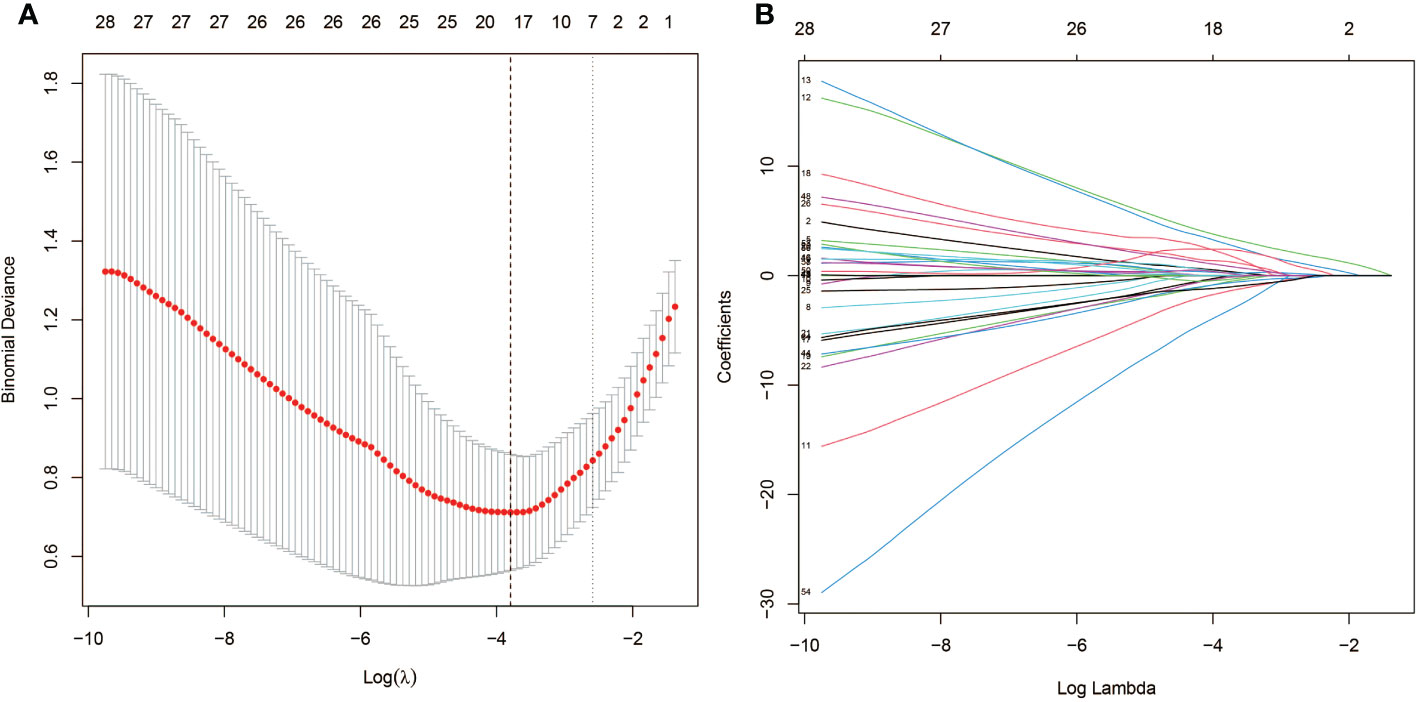
Figure 2 Demographic and clinical feature selection using the LASSO binary logistic regression model. (A) Optimal parameter (lambda) selection in the LASSO model used fivefold cross-validation via minimum criteria. (B) LASSO coefficient profiles of the 72 features. A coefficient profile plot was produced against the log(lambda) sequence. Vertical line was drawn at the value selected using fivefold cross-validation, where optimal lambda resulted in five features with nonzero coefficients.
Nomogram development and internal validation
Logistic regression analysis using the above four factors such as lumber T score, femur T score, Niacin B3, and Vitamin D have been indicated in Table 6. Models with the above independent predictors have been developed and presented in the form of nomograms (Figure 3). The risk calibration curve for the non-concordant isotype map (Figure 4) showed good agreement in this group of patients (Figure 4). The nomogram C-index predicted by the training group was 0.938 (95% CI: -1.83 to 1.39), and the initiation control C-index was 0.95, indicating good discrimination. The breach risk graph shows good predictability.
Clinical application
The decision curve analysis for osteoporosis and rotator cuff injury is shown in Figure 4. Decision curves suggest that the use of this prediction nomogram to predict the risk of osteoporosis-related rotator cuff injury is more favorable than this protocol. When the threshold patient and physician probabilities were more than equal to 14 and less than 88%, respectively. Within this range, the net benefit was comparable with several overlaps, based on the pediction nomogram. ROC curves of the RCTs and RCTs-OP signature is shown in Figure 5. The AUC of the osteoporosis associated with rotator cuff injury nomogram was higher than that of the clinical factor model (p = 0.035, AUC=0.938) in the training set and there was a significant difference in the AUC between the osteoporosis associated with rotator cuff injury nomogram and clinical factors model in the validation set (p = 0.012, AUC=0.961).
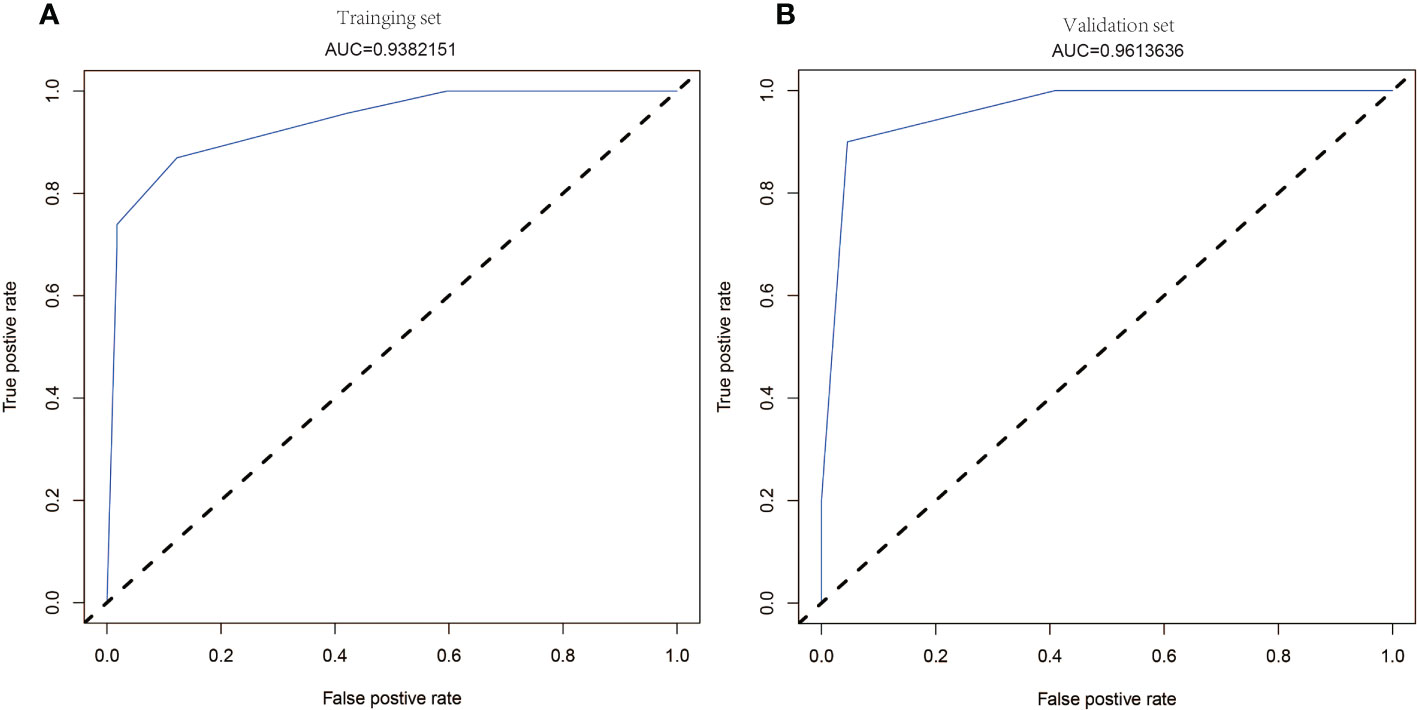
Figure 5 The ROC curves of the nomogram in traning and validation sets, respectively. The ROC curves of the nomogram are outperformed than the clinlical signature in both the training (A) and validation (B) sets.
Correlation between serum vitamin D level with baseline characteristic of RCTs-OP patients
The results of the clinical predictive model found that vitamin D is an independent predictive shadow that affects rotator cuff injury with osteoarthritis, so we further use vitamin D as a basis for further grouping. Patients with RCTs-OP were subdivided into high- vitamin D and low vitamin D group (Table 7). As shown in Table 7. The patients with high vitamin D group have low risk in stoke than patients with low vitamin D level. In addition, the OCN, CTX, alanine, Glutamic_acid, 3_Aminoisobutyric_acid, Vitamin_B1, Vitamin_B6, Vitamin_A in high vitamin D group than low vitamin D group but phenylalanine, Sarcosine, Biotin_B7, Vitamin_E and Vitamin_K1 were low in high vitamin D group than low vitamin D group.
Furthermore, while a correlation was established between vitamin D with baseline characteristic of RCTs-OP patients. It is found that the serum vitamin D were negative correlated with Hyertension, diabete, serine, proline, isoleucine, threonine and biotin B7 but positive correlated with CTX, 3 Aminoisobutyric acid, Vitamin B1, Vitamin B2, Vitamin_B6, Vitamin C and Vitamin A (Supplement Table 4). This further suggests that vitamin D level was an independent factor in those with RCTs-OP patients.
Discussion
Rotator cuff repair surgery in patients with osteoporosis is now receiving increasing attention, and anti-osteoporosis treatment has shown significant results in improving rotator cuff repair surgery (38). There is a clear association between osteoporosis and rotator cuff injury in clinical studies. In previous studies, rotator cuff injuries patients with osteoporosis have a 1.79 times higher risk than those patient without osteoporosis (39). Aiming to establish a prognostic system independent of clinical characteristics, bone metabolism marker, amino acid, and serum vitamin. We assessed multiple clinical characteristics, bone metabolism marker, amino acid, and serum vitamin closely related to host RCTs related OP status. This findings of this study demonstrate that OP with RCTs has a lower level of in 25-vitD, OCN, serum Ca2+,ornithine, diaminocaproic_acid but the high level of γ_aminobutyric_acid, Vitamin_C, Vitamin_D3 and Vitamin_E, Vitamin_B12, than RCTs patients without OP. In addition. the prediction model for risk among RCTs with OP merely used four easily available variables and appeared more effective clinical response index. At the same time, the use of training cohorts and validation cohorts further improved the accuracy of prognostic indicators. Finally, Multivariable logistic regression revealed that low serum VitD level was an independent risk factor for RCTs-OP patients. Thus, vitamin D level may be valuable prognostic biomarkers that reflect the combined effect of vitamins on the progression of RCT-related OP.
Nomograms are widely used as diagnostic methods in oncology and medicine which can manifest as very friendly interfaces, accuracy, and ease of understanding to help make clinical diagnoses (40, 41). Our study is the first to study the relationship between rotator cuff injury and osteoporosis using the nomograms method. Addition of risk factors for demographic, pathological, and treatment characteristics into an easy-to-use nomogram facilitates individual prediction of surgical risk using RCTs. Finally, the internal cohort validation showed good discriminative strength and calibration efficiency; in particular, the c-index was high for range validation, indicating that the nomogram has a large sample size and can be used widely and accurately (40, 42). The multivariate Logistic regression analysis has been carried out with clinical factors and it also found that femur T score, Vitamin D and vitamin B12 have significantly different between RCTs with OP or without OP. Data on prevalence and identification of underlying risk factors facilitate early diagnosis of randomized controlled trials and improve treatment outcomes (43).
During the healing process of tendon bone, obvious bone mass loss was found in the area, including the proximal tibia of the anterior cruciate ligament and the calcaneal bone after Achilles tendon injury (44, 45). Osteoporosis increases the revision rate of rotator cuff repair due to lower bone mass at the insertion of the humeral cephalic tendon (46). Consistent with the literature, this research found that participants who reported rotator cuff injuries have consistent changes in BMD and T-values of the lumbar spine, femoral head, and humerus. This means that proximal humerus BMD is highly reliable and can be accurately assessed preoperatively in patients requiring suture anchors for rotator cuff repair and in patients with proximal humerus fractures (47). Besides, Osteoporosis affects the healing of the rotator cuff, and the possible cause is related to the fact that high osteoclast activity can lead to poor healing of the injury interface in the early stages (39, 48). However, in our study, Indicators of osteoclast activity in serology did not show significant changes in patients with rotator cuff injury with osteoporosis which may be associated with increased local osteoclast activity but insignificant serologic osteoclast activity changes.
PTH and OCN are also important diagnostic markers of osteoporosis. In our study, it was also found that patients with rotator cuff injuries with osteoporosis experience changes in OCN and PTH levels. A close association between PTH and OCN and rotator cuff injury was also found in multiple regression models. Yoon et al.found that Local administration of PTH via an absorbable scaffold improves biomechanical and histological treatment of rotator cuff in rat tendons (49). Lower levels of osteocalcin have also been found in tenocyte-like cells from the human rotator cuff which are in line with those of our studies (50).
Vitamins D are essential constituents of our diet that have long been known to influence human health (51). Preliminary data suggest that vitamins D can promote tendon growth and healing and improve bone mass. Serum vitamin D levels were significantly negatively correlated with cuff steatosis and significantly positively correlated with isokinetic muscle circulation (52). Vitamin D insufficiency was associated with rotator cuff muscle strength in professional volleyball athletes (11). Jourdan et al. investigated Association between serum 25-hydroxyvitamin D levels and failure of arthroscopic rotator cuff repair and statistically significant association between serum 25-hydroxyvitamin D deficiency and rotator cuff deficiency and frequency of controls (53). In addition, Vitamin B12 is also closely associated with rotator cuff injuries. Vitamin B12 deficiency can lead to high levels of homocysteine, which interferes with collagen cross-linking, thereby compromising tendon integrity (13). Chi et al. found that Vitamin B12, vitamin D and angiopoietin are significantly reduced in tendon disorders, which may contribute to a better understanding of the complex pathology of tendon disorders (54). High vitamin D level also promote bone health (55). Garicia et al.also found that associations between 25(OH)D concentrations during fetal life with BMC and bone area in childhood, but these associations were no longer significant after adjustment for childhood 25(OH)D status (56). What’s more, poor vitamin D status is common in patients with impaired renal function and represents one main component of the complex scenario of chronic kidney disease-mineral and bone disorder (57). Vitamin D status also Established risk factors for osteoporosis and associated fractures (58). Cochrane review investigated that Vitamin D and related compounds have been used to prevent osteoporotic fractures in older people (59). consensus statement from the European Society for Clinical and Economic Aspects of Osteoporosis and Osteoarthritis (ESCEO) found that vitamin D play important role in maintaining musculoskeletal health in postmenopausal women (60). Whether vitamin D levels also have a clear effect on rotator cuff injury and osteoporosis is an important issue in our study. Therefore, more research on tendon health and nutrition is needed, possibly because tendon health requires more nutrients and a multi-nutrient intervention may be more effective than a single nutritional strategy.
Amino acid levels play an important role in tendon-bone healing which act as another important nutrient. The addition of amino acids to glutamine, arginine, and branched-chain amino acids (leucine, isoleucine, and valine) significantly increased skin collagen synthesis in UV-irradiated mice (61). Several studies have shown that dietary intake of leucine stimulates protein synthesis in mammals through the rapamycin signaling pathway (62). Other studies have shown that oral addition of a mixture of methyl beta-hydroxy-beta-butyrate, glutamine, and arginine can significantly increase muscle mass and muscle mass, or both, even in older adults. in this way (63). These results support our study that leucine or other nutrients can increase tenascin synthesis and function. Therefore, the lack of understanding of the relationship between diet and tenascin requires extensive research in this field (64, 65).
Our study developed a novel nomogram with relatively good accuracy to help physicians understand osteoporosis risk in RCT patients, including clinical features, markers of bone metabolism, amino acids, and serum vitamins. By assessing individual risk, surgeons and patients can conduct BMD monitoring and medical interventions where they are most needed. This nomogram requires external validation, and more research is needed to determine whether individualized interventions based on this nomogram can improve treatment outcomes.
Limitations
There are some limitations in interpreting our results. First, the retrospective nature of the study design was limited by the accuracy of the data stored in the graphs. At the time of data collection, the Department of Sports Medicine had no formal osteoporosis screening program; therefore, these numbers may not reflect other institutions that use screening programs. Second, the study did not examine clinical outcomes in healthy people or the effect of bone health on outcomes. Finally, these figures reflect the number of patients in the geographic region of China. It is unclear whether these data reflect patient populations in other regions.
Conclusion
The main goal of the current study was to determine the relationship between RCTs and OP and found that vitamin D are valuable prognostic biomarkers, reflecting the combined effect of vitamins on RCTs related OP progression. These findings also highlight that nutrients condition such as vitamins and amino acids of patients provide a new understanding of the development of RCTs.
Data availability statement
The original contributions presented in the study are included in the article/Supplementary Material. Further inquiries can be directed to the corresponding authors.
Ethics statement
This study was reviewed and approved by the ethics committee and the institutional review board (IRB) of The Shanghai Tenth People’s Hospital of Tongji University (SHSY-IEC-KY-4.0/19-05/01). Written informed consent was obtained from the owners for the participation of their animals in this study.
Author contributions
Conception and design: GJL, WJL. Acquisition, analysis, and interpretation of the data: GJL, WJL, LYZ, CZ. Drafting and writing: CZ, RJC. Final approval of the article: GJL, WJL, LYZ, CZ, RJC. All authors contributed to the article and approved the submitted version.
Funding
This research was funded by Clinical research project of Shanghai Tenth People’s Hospital (Grants no. YSDDSD11W).
Acknowledgments
We would like to thank all participants and our hospital.
Conflict of interest
The authors declare that the research was conducted in the absence of any commercial or financial relationships that could be construed as a potential conflict of interest.
Publisher’s note
All claims expressed in this article are solely those of the authors and do not necessarily represent those of their affiliated organizations, or those of the publisher, the editors and the reviewers. Any product that may be evaluated in this article, or claim that may be made by its manufacturer, is not guaranteed or endorsed by the publisher.
Supplementary material
The Supplementary Material for this article can be found online at: https://www.frontiersin.org/articles/10.3389/fendo.2022.1017835/full#supplementary-material
References
1. Minagawa H, Yamamoto N, Abe H, Fukuda M, Seki N, Kikuchi K, et al. Prevalence of symptomatic and asymptomatic rotator cuff tears in the general population: From mass-screening in one village. J Orthopaedics (2013) 10(1):8–12. doi: 10.1016/j.jor.2013.01.008
2. Henry P. ACP journal club. in rotator cuff tears, primary tendon repair was better than physiotherapy for some measures of function at 5 y. Ann Internal Med (2015) 162(6):Jc11. doi: 10.7326/acpjc-2015-162-6-011
3. Hermans J, Luime JJ, Meuffels DE, Reijman M, Simel DL, Bierma-Zeinstra SM. Does this patient with shoulder pain have rotator cuff disease?: the rational clinical examination systematic review. Jama (2013) 310(8):837–47. doi: 10.1001/jama.2013.276187
4. Colvin AC, Egorova N, Harrison AK, Moskowitz A, Flatow EL. National trends in rotator cuff repair. J Bone Joint Surg Am volume. (2012) 94(3):227–33. doi: 10.2106/jbjs.J.00739
5. Guevara JA, Entezari V, Ho JC, Derwin KA, Iannotti JP, Ricchetti ET. An update on surgical management of the repairable Large-to-Massive rotator cuff tear. J Bone Joint Surg Am (2020) 102(19):1742–54. doi: 10.2106/jbjs.20.00177
6. Keener JD, Patterson BM, Orvets N, Chamberlain AM. Degenerative rotator cuff tears: Refining surgical indications based on natural history data. J Am Acad Orthopaedic Surgeons (2019) 27(5):156–65. doi: 10.5435/jaaos-d-17-00480
7. Longo UG, Risi Ambrogioni L, Candela V, Berton A, Carnevale A, Schena E, et al. Conservative versus surgical management for patients with rotator cuff tears: a systematic review and META-analysis. BMC Musculoskeletal Disord (2021) 22(1):50. doi: 10.1186/s12891-020-03872-4
8. Yoon TH, Kim SJ, Choi YR, Shin JC, Alruwaili SH, Chun YM. Anterior rotator cable disruption does not affect outcomes in rotator cuff tear with subscapularis involvement. Knee Surgery Sports Traumatol Arthroscopy Off J ESSKA (2021) 29(1):154–61. doi: 10.1007/s00167-020-05891-z
9. Chen X, Jones IA, Togashi R, Park C, Vangsness CT Jr. Use of platelet-rich plasma for the improvement of pain and function in rotator cuff tears: A systematic review and meta-analysis with bias assessment. Am J Sports Med (2020) 48(8):2028–41. doi: 10.1177/0363546519881423
10. Entezari V, Lazarus M. Surgical considerations in managing osteoporosis, osteopenia, and vitamin d deficiency during arthroscopic rotator cuff repair. Orthopedic Clinics North Am (2019) 50(2):233–43. doi: 10.1016/j.ocl.2018.10.006
11. Kim DK, Park G, Kuo LT, Park WH. The relationship between vitamin d status and rotator cuff muscle strength in professional volleyball athletes. Nutrients (2019) 11(11–29). doi: 10.3390/nu11112768
12. Kim DM, Shim IK, Shin MJ, Choi JH, Lee YN, Jeon IH, et al. A combination treatment of raloxifene and vitamin d enhances bone-to-Tendon healing of the rotator cuff in a rat model. Am J Sports Med Jul (2020) 48(9):2161–9. doi: 10.1177/0363546520927015
13. Kim JH, Kim GT, Yoon S, Lee HI, Ko KR, Lee SC, et al. Low serum vitamin B(12) levels are associated with degenerative rotator cuff tear. BMC Musculoskeletal Disord (2021) 22(1):364. doi: 10.1186/s12891-021-04231-7
14. Zheng R, Huang S, Zhu J, Lin W, Xu H, Zheng X. Leucine attenuates muscle atrophy and autophagosome formation by activating PI3K/AKT/mTOR signaling pathway in rotator cuff tears. Cell Tissue Res (2019) 378(1):113–25. doi: 10.1007/s00441-019-03021-x
15. Compston JE, McClung MR, Leslie WD. Osteoporosis. Lancet (London England) (2019) 393(10169):364–76. doi: 10.1016/s0140-6736(18)32112-3
16. Eastell R, Szulc P. Use of bone turnover markers in postmenopausal osteoporosis. Lancet Diabetes Endocrinol (2017) 5(11):908–23. doi: 10.1016/s2213-8587(17)30184-5
17. Qaseem A, Forciea MA, McLean RM, Denberg DT, Barry MJ, Cooke M, et al. Treatment of low bone density or osteoporosis to prevent fractures in men and women: A clinical practice guideline update from the American college of physicians. Ann Internal Med (2017) 166(11):818–39. doi: 10.7326/m15-1361
18. He Z, Zheng J, Liu S, Guan Z, Zhou Q, Jin X, et al. The effect of whole-body vibration in osteopenic patients after total knee arthroplasty: a randomized controlled trial. Aging Clin Exp Res (2022) 10:2–34. doi: 10.1007/s40520-021-02043-2
19. Aspray TJ, Hill TR. Osteoporosis and the ageing skeleton. Sub-Cellular Biochem (2019) 91:453–76. doi: 10.1007/978-981-13-3681-2_16
20. Ensrud KE, Crandall CJ. Osteoporosis. Ann Internal Med (2017) 167(3):Itc17–itc32. doi: 10.7326/aitc201708010
21. Chalmers PN, Granger E, Nelson R, Yoo M, Tashjian RZ. Factors affecting cost, outcomes, and tendon healing after arthroscopic rotator cuff repair. Arthroscopy J Arthroscopic Related Surg Off Publ Arthroscopy Assoc North America Int Arthroscopy Assoc (2018) 34(5):1393–400. doi: 10.1016/j.arthro.2017.11.015
22. Kim YK, Jung KH, Kim JW, Kim US, Hwang DH. Factors affecting rotator cuff integrity after arthroscopic repair for medium-sized or larger cuff tears: a retrospective cohort study. J Shoulder Elbow Surg (2018) 27(6):1012–20. doi: 10.1016/j.jse.2017.11.016
23. Atala NA, Bongiovanni SL, Galich AM, Bruchmann MG, Rossi LA, Tanoira I, et al. Is sarcopenia a risk factor for rotator cuff tears? J Shoulder Elbow Surgery (2021) 30(8):1851–5. doi: 10.1016/j.jse.2020.10.001
24. Cancienne JM, Brockmeier SF, Kew ME, Deasey MJ, Werner BC. The association of osteoporosis and bisphosphonate use with revision shoulder surgery after rotator cuff repair. Arthroscopy J Arthroscopic Related Surg Off Publ Arthroscopy Assoc North America Int Arthroscopy Assoc (2019) 35(8):2314–20. doi: 10.1016/j.arthro.2019.03.036
25. Cotter EJ, Klosterman EL, Winzenried AE, Greiner JJ, Grogan BF. Osteoporosis screening is often indicated but overlooked prior to rotator cuff repair. Arthroscopy Sports Med Rehabil (2021) 3(3):e659–65. doi: 10.1016/j.asmr.2021.01.002
26. Kirchhoff C, Braunstein V, Milz S, Sprecher CM, Fischer F, Tami A, et al. Assessment of bone quality within the tuberosities of the osteoporotic humeral head: relevance for anchor positioning in rotator cuff repair. Am J Sports Med (2010) 38(3):564–9. doi: 10.1177/0363546509354989
27. Kirchhoff C, Kirchhoff S, Sprecher CM, Ahrens P, Imhoff AB, Hinterwimmer S, et al. X-Treme CT analysis of cancellous bone at the rotator cuff insertion in human individuals with osteoporosis: superficial versus deep quality. Arch Orthopaedic Trauma Surgery (2013) 133(3):381–7. doi: 10.1007/s00402-012-1663-8
28. Fehringer EV, Sun J, VanOeveren LS, Keller BK, Matsen FA 3rd. Full-thickness rotator cuff tear prevalence and correlation with function and co-morbidities in patients sixty-five years and older. J Shoulder Elbow Surgery (2008) 17(6):881–5. doi: 10.1016/j.jse.2008.05.039
29. Saag KG, Petersen J, Brandi ML, Karaplis AC, Lorentzon M, Thomas T, et al. Romosozumab or alendronate for fracture prevention in women with osteoporosis. N Engl J Med (2017) 377(15):1417–27. doi: 10.1056/NEJMoa1708322
30. Dennis RA, Przybyla B, Gurley C, Kortebein PM, Simpson P, Sullivan DH, et al. Aging alters gene expression of growth and remodeling factors in human skeletal muscle both at rest and in response to acute resistance exercise. Physiol Genomics (2008) 32(3):393–400. doi: 10.1152/physiolgenomics.00191.2007
31. Longo UG, Franceschi F, Ruzzini L, Spiezia F, Maffulli N, Denaro V. Higher fasting plasma glucose levels within the normoglycaemic range and rotator cuff tears. Br J Sports Med (2009) 43(4):284–7. doi: 10.1136/bjsm.2008.049320
32. McCarthy PT, Harrington DJ, Shearer MJ. Assay of phylloquinone in plasma by high-performance liquid chromatography with electrochemical detection. Methods Enzymol (1997) 282:421–33. doi: 10.1016/s0076-6879(97)82125-8
33. Kidd AC, McGettrick M, Tsim S, Halligan DL, Bylesjo M, Blyth KG. Survival prediction in mesothelioma using a scalable lasso regression model: instructions for use and initial performance using clinical predictors. BMJ Open Respir Res (2018) 5(1):e000240. doi: 10.1136/bmjresp-2017-000240
34. Xing J, Min L, Zhu S, Zhang H, Zhao Y, Li H, et al. Factors associated with gastric adenocarcinoma and dysplasia in patients with chronic gastritis: a population-based study. Chin J Cancer Res = Chung-kuo yen cheng yen chiu (2017) 29(4):341–50. doi: 10.21147/j.issn.1000-9604.2017.04.07
35. Balachandran VP, Gonen M, Smith JJ, DeMatteo RP. Nomograms in oncology: more than meets the eye. Lancet Oncol Apr (2015) 16(4):e173–80. doi: 10.1016/s1470-2045(14)71116-7
36. Vickers AJ, Cronin AM, Elkin EB, Gonen M. Extensions to decision curve analysis, a novel method for evaluating diagnostic tests, prediction models and molecular markers. BMC Med Inf Decision Making (2008) 8:53. doi: 10.1186/1472-6947-8-53
37. Huang YQ, Liang CH, He L, Tian J, Liang CH, Chen X, et al. Development and validation of a radiomics nomogram for preoperative prediction of lymph node metastasis in colorectal cancer. J Clin Oncol Off J Am Soc Clin Oncol (2016) 34(18):2157–64. doi: 10.1200/jco.2015.65.9128
38. Xu J, Ye Z, Chen C, Zhang X, Han K, Wu X, et al. Abaloparatide improves rotator cuff healing via anabolic effects on bone remodeling in a chronic rotator cuff tear model of rat with osteoporosis: A comparison with denosumab. Am J Sports Med (2022) 50(6):1550–63. doi: 10.1177/03635465221079651
39. Hong JP, Huang SW, Lee CH, Chen HC, Charoenpong P, Lin HW. Osteoporosis increases the risk of rotator cuff tears: a population-based cohort study. J Bone Mineral Metab (2022) 40(2):348–56. doi: 10.1007/s00774-021-01293-4
40. Wei L, Champman S, Li X, Li X, Li S, Chen R, et al. Beliefs about medicines and non-adherence in patients with stroke, diabetes mellitus and rheumatoid arthritis: a cross-sectional study in China. BMJ Open (2017) 7(10):e017293. doi: 10.1136/bmjopen-2017-017293
41. Wang H, Zhang L, Liu Z, Wang X, Geng S, Li J, et al. Predicting medication nonadherence risk in a Chinese inflammatory rheumatic disease population: development and assessment of a new predictive nomogram. Patient Preference Adherence (2018) 12:1757–65. doi: 10.2147/ppa.S159293
42. Nie P, Yang G, Wang Z, Yan L, Miao W, Hao D, et al. A CT-based radiomics nomogram for differentiation of renal angiomyolipoma without visible fat from homogeneous clear cell renal cell carcinoma. Eur Radiol (2020) 30(2):1274–84. doi: 10.1007/s00330-019-06427-x
43. Liem D, Buschmann VE, Schmidt C, Gosheger G, Vogler T, Schulte TL, et al. The prevalence of rotator cuff tears: is the contralateral shoulder at risk? Am J Sports Med (2014) 42(4):826–30. doi: 10.1177/0363546513519324
44. Leppälä J, Kannus P, Natri A, Pasanen M, Sievänen H, Vuori I, et al. Effect of anterior cruciate ligament injury of the knee on bone mineral density of the spine and affected lower extremity: a prospective one-year follow-up study. Calcified Tissue Int (1999) 64(4):357–63. doi: 10.1007/s002239900632
45. Silva MJ, Ritty TM, Ditsios K, Burns ME, Boyer MI, Gelberman RH. Tendon injury response: assessment of biomechanical properties, tissue morphology and viability following flexor digitorum profundus tendon transection. J orthopaedic Res Off Publ Orthopaedic Res Society (2004) 22(5):990–7. doi: 10.1016/j.orthres.2004.01.004
46. Schanda JE, Keibl C, Heimel P, Monforte X, Tangl S, Feichtinger X, et al. Zoledronic acid substantially improves bone microarchitecture and biomechanical properties after rotator cuff repair in a rodent chronic defect model. Am J Sports Med (2020) 48(9):2151–60. doi: 10.1177/0363546520926471
47. Oh JH, Song BW, Kim SH, Choi JA, Lee JW, Chung SW, et al. The measurement of bone mineral density of bilateral proximal humeri using DXA in patients with unilateral rotator cuff tear. Osteoporosis Int J established as result cooperation between Eur Foundation Osteoporosis Natl Osteoporosis Foundation USA (2014) 25(11):2639–48. doi: 10.1007/s00198-014-2795-1
48. Mall NA, Tanaka MJ, Choi LS, Paletta GA Jr. Factors affecting rotator cuff healing. J Bone Joint Surg Am volume. (2014) 96(9):778–88. doi: 10.2106/jbjs.M.00583
49. Yoon JP, Chung SW, Jung JW, Lee YS, Kim KI, Park GY, et al. Is a local administration of parathyroid hormone effective to tendon-to-Bone healing in a rat rotator cuff repair model? J Orthopaedic Res Off Publ Orthopaedic Res Society (2020) 38(1):82–91. doi: 10.1002/jor.24452
50. Pauly S, Klatte F, Strobel C, Schmidmaier G, Greiner S, Scheibel M, et al. Characterization of tendon cell cultures of the human rotator cuff. Eur Cells Materials (2010) 20:84–97. doi: 10.22203/ecm.v020a08
51. Mora JR, Iwata M, von Andrian UH. Vitamin effects on the immune system: vitamins a and d take centre stage. Nat Rev Immunol (2008) 8(9):685–98. doi: 10.1038/nri2378
52. Oh JH, Kim SH, Kim JH, Shin YH, Yoon JP, Oh CH. The level of vitamin d in the serum correlates with fatty degeneration of the muscles of the rotator cuff. J Bone Joint Surg Br (2009) 91(12):1587–93. doi: 10.1302/0301-620x.91b12.22481
53. Cancienne JM, Brockmeier SF, Kew ME, Werner BC. Perioperative serum 25-hydroxyvitamin d levels affect revision surgery rates after arthroscopic rotator cuff repair. Arthroscopy J Arthroscopic Related Surg Off Publ Arthroscopy Assoc North Ama Int Arthroscopy Assoc (2019) 35(3):763–9. doi: 10.1016/j.arthro.2018.09.032
54. Lo CN, Leung BPL, Ngai SPC. The usefulness of serological inflammatory markers in patients with rotator cuff disease-a systematic review. Medicina (Kaunas Lithuania) (2022) 58(2–62). doi: 10.3390/medicina58020301
55. Lippi G, Targher G. High-dose vitamin d supplementation and bone health. Jama (2020) 323(1):92. doi: 10.1001/jama.2019.18138
56. Garcia AH, Erler NS, Jaddoe VWV, Tiemeier H, van den Hooven EH, Franco OH, et al. 25-hydroxyvitamin d concentrations during fetal life and bone health in children aged 6 years: a population-based prospective cohort study. Lancet Diabetes Endocrinol (2017) 5(5):367–76. doi: 10.1016/s2213-8587(17)30064-5
57. Cianciolo G, Cappuccilli M, Tondolo F, Gasperoni L, Zappulo F, Barbuto S, et al. Vitamin d effects on bone homeostasis and cardiovascular system in patients with chronic kidney disease and renal transplant recipients. Nutrients (2021) 13(5–25). doi: 10.3390/nu13051453
58. Kelsey JL. Risk factors for osteoporosis and associated fractures. Public Health Rep (Washington DC 1974) (1989) 104 Suppl(Suppl):14–20.
59. Avenell A, Mak JC, O'Connell D. Vitamin d and vitamin d analogues for preventing fractures in post-menopausal women and older men. Cochrane Database Syst Rev (2014) 2014(4):Cd000227. doi: 10.1002/14651858.CD000227.pub4
60. Rizzoli R, Stevenson JC, Bauer JM, van Loon LJ, Walrand S, Kanis JA, et al. The role of dietary protein and vitamin d in maintaining musculoskeletal health in postmenopausal women: a consensus statement from the European society for clinical and economic aspects of osteoporosis and osteoarthritis (ESCEO). Maturitas (2014) 79(1):122–32. doi: 10.1016/j.maturitas.2014.07.005
61. Murakami H, Shimbo K, Inoue Y, Takino Y, Kobayashi H. Importance of amino acid composition to improve skin collagen protein synthesis rates in UV-irradiated mice. Amino Acids (2012) 42(6):2481–9. doi: 10.1007/s00726-011-1059-z
62. Rennie MJ. Exercise- and nutrient-controlled mechanisms involved in maintenance of the musculoskeletal mass. Biochem Soc Trans (2007) 35(Pt 5):1302–5. doi: 10.1042/bst0351302
63. Baier S, Johannsen D, Abumrad N, Rathmacher JA, Nissen S, Flakoll P. Year-long changes in protein metabolism in elderly men and women supplemented with a nutrition cocktail of beta-hydroxy-beta-methylbutyrate (HMB), l-arginine, and l-lysine. JPEN J Parenteral Enteral Nutr (2009) 33(1):71–82. doi: 10.1177/0148607108322403
64. Curtis L. Nutritional research may be useful in treating tendon injuries. Nutr (Burbank Los Angeles County Calif) (2016) 32(6):617–9. doi: 10.1016/j.nut.2015.12.039
Keywords: rotator cuff, osteoporosis, nutrient levels, LASSO, biomarkers
Citation: Liu G, Li W, Zhang L, Zhou C and Cong R (2022) The role of vitamin D on rotator cuff tear with osteoporosis. Front. Endocrinol. 13:1017835. doi: 10.3389/fendo.2022.1017835
Received: 17 August 2022; Accepted: 24 October 2022;
Published: 18 November 2022.
Edited by:
Antonino Catalano, University of Messina, ItalyReviewed by:
Tonghe Zhu, Shanghai University of Engineering Sciences, ChinaHua Huang, The First Affiliated Hospital and College of Clinical Medicine of Henan University of Science and Technology, China
Copyright © 2022 Liu, Li, Zhang, Zhou and Cong. This is an open-access article distributed under the terms of the Creative Commons Attribution License (CC BY). The use, distribution or reproduction in other forums is permitted, provided the original author(s) and the copyright owner(s) are credited and that the original publication in this journal is cited, in accordance with accepted academic practice. No use, distribution or reproduction is permitted which does not comply with these terms.
*Correspondence: Chao Zhou, Q2hpbmEzMTA2NjcyNzA1QHFxLmNvbQ==; Ruijun Cong, Y3JqZ0AxNjMuY29t
†These authors have contributed equally to this work
 Gejun Liu1†
Gejun Liu1†